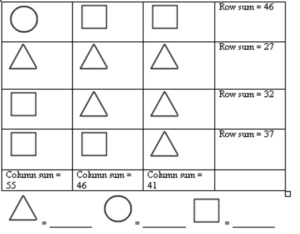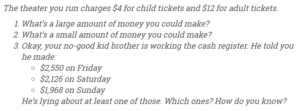This is part of our Best of the Web series, where we scour the Internet for the best free activities available today. By best, we’re looking for activities that engage the class with interesting puzzles and meaningful learning. Two posts from Dan Meyer help clarify: Culture Beats Curriculum and Real Work vs. Real World.
#1: Systems of Equations Puzzles
Tina Cardone consolidated a nice set of puzzles for linear systems. These puzzles give students an intuitive anchor for systems. That anchor makes for an easy transition to representing systems algebraically and helps show why linear systems can only have one, zero, or infinite solutions. This post links to shape puzzles, the classic Noah’s Ark (created by Fawn Nguyen), and tape diagrams. These are all great for introducing the unit. (Mimi’s shape puzzles are a personal favorite.) Here’s Tina’s post: Drawing on Math – Systems of Equations.
#2: Desmos Linear Systems Bundle
Dan Meyer is now Chief Academic Officer at Desmos, so it’s no surprise that it has a lovely suite of activities for linear systems. They’re excellent for building a conceptual foundation for systems of equations and representing them graphically and algebraically. The bundle currently has the following activities, each of which take between 30 and 60 minutes to complete.
- Polygraph: Linear Systems – Understand and describe key features of linear systems

- Systems of Two Linear Equations – Develop a conceptual foundation for systems
- Solutions to Systems of Linear Equations – Understand what it means to solve a system
- Racing Dots / Wafers and Creme – Build and model a system of equations to solve a problem
- Card Sort: Linear Systems – Practice solving, graphing, and analyzing systems
Polygraph works best with a device for each student, but with a touch of creativity the rest can work with a single projector and whiteboard for the class. Here’s the link: Desmos – Linear Systems Bundle.
#3: Three Act Upgrades
Dan Meyer has upgraded a few of the most classic, soul-crushing systems problems out there. As you know, he specializes in creating an intellectual need for concepts–problems designed to make students want to solve them. Here are two of those upgrades:
- The Coin Problem: If you have this many coins and that much money, how much of each coin do we have? Dan offers a big improvement to this that creates a desire to solve a problem and a desire to learn an efficient way to do it (i.e. by learning how create and solve systems, rather than endlessly guessing and testing). His featured Twitter responses have lots of great ways of building on this. Here it is: Three Acts – Systems of Equations.
- The Movie Ticket Problem: If a child’s ticket costs this much, an adult
ticket costs that much, you make this much money, and that many people came to the movies that night, how many children and adults were there? Dan’s solution is simple and elegant. The mechanics of his problem are the same, but the need to solve it is authentic. Dan Meyer Makeover – Systems of Equations.
#4: MARS Systems of Equations
MARS activities focus on helping students generate, interpret, and critique mathematical ideas. You can use these for an entire lesson or pull out individual questions for quick think-write-pair-shares or for full class discussions. MARS has two great resources for systems of equations. The first bridges students from linear equations to systems of linear equations (Solving Linear Equations in Two Variables) and the second is a card sort activity focusing on what it means to solve a system (Classifying Solutions to Systems of Equations).
#5: “Real World” Problems and Activities
There’s a big range among “real world” problems. Some lead to meaningful learning and connections, while some are simplistic and contrived. Coupled with the right open ended discussion questions, these are a few of the stronger ones. Most take just 10 or so minutes, but a few need a full class. They’re sorted by “good for” graphing, substitution, and elimination, but know that most can comfortably fall in more than one category.
Good for Graphing / Tables
- Dan Meyer: Dueling Discounts or Robert Kaplinsky: Bed, Bath & Beyond and Michaels Coupon
- Emergent Math: U-Haul Scenario (full class)
- Robert Kaplinsky: Lemonade Stand (full class)

Good for Substitution
Good for Elimination
- Learn NC: Basketball Stats (easily adjustable to any basketball player)
#6: ChalkDoc Systems of Equations

I’ll throw my hat in the ring. In class, our favorite systems of equations activity is The Custom Ink Project. It’s a full class activity that mixes art and math in which students design an original shirt, see what the class would pay for it, build a cost / revenue system, and then analyze how they’d do if they really started selling their creation at school. Students love the balance of inspiration, calculation, and competition, which made this an annual favorite in my classroom. Here’s the link: The Custom Ink Project: Systems of Equations.
We also offer lots of quick, free problems for creating, solving, and analyzing systems that you can steal to build customized activities, worksheets, homework, and tests. Here’s an example: Systems of Equation Worksheet – ChalkDoc.
Tell Me What’s Missing!
I’ll update this post as new, helpful resources emerge. If you have any thoughts, suggestions, questions, or requests, please let me know!




All 3 methods”, “You tube video solving systems”, “This music video is a fun way to either introduce or wrap up a lesson for solving linear equations.